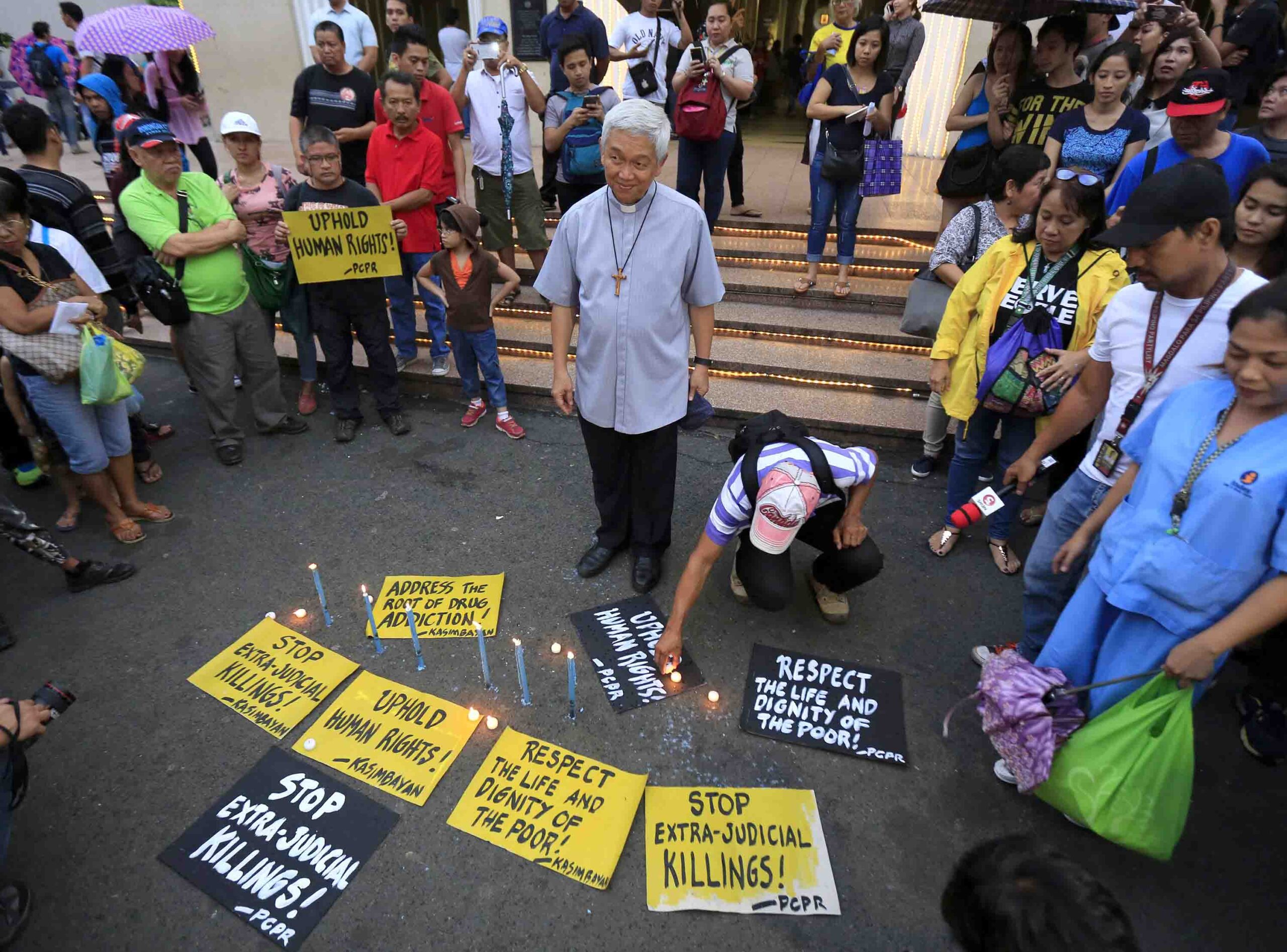At the onset of Ash Wednesday, the chanting of the Pasyong Mahal, called Pabasa can be heard in various neighborhoods. The text has its origin in the pre-Hispanic Filipino art of chanting epic poems as part of oral tradition. The Spaniards introduced it in the 16th century, and the first written version was Ang Mahal na Pasión ni Jesu Christong Panginoon Natin na Tola by Gaspar Aquino de Belen, written in 1703 and approved in 1704.
However, the most popular Pasyon version in Tagalog is the Casaysayan nang Pasiong Mahal ni Hesucristong Panginoon Natin na Sucat Ipag-alab nang Puso nang Sinomang Babasa. As indicated in the book’s title page, it was commissioned by Archbishop José Seguí, O.S.A., of Manila, and Fr. Manuel Grijalvo, O.S.A., Augustinian Provincial.
It is also called Pasyong Genesis since it begins with the Genesis creation narrative, after the prayers, as well as Pasyong Pilapil because of the foreword of the priest, Dr. Mariano Pilapil, found in the 1814 edition.
While the chanting of the Pasyon is primarily heard during Holy Week until 3:00 p.m. of Good Friday, it can also be heard during Lent, depending on the panata or vow made by individuals or families on when to hold it. It is chanted in a mournful tone called tagulaylay. The Pabasa is held before the family altar, in chapels, or a male-shift altar called kubol. Even parishes hold a Pabasang Bayan during Holy Week. The host of the Pabasa offer food and drinks called caridad to the chanters and visitors as a sign of hospitality and Christian charity.
In their Pastoral Letter on Filipino Spirituality in 1999, the Philippine Bishops reflected on the Pasyon, which “is not just a simple singing of the passion narrative, but it is an uninterrupted cry and proclamation of the pain and sorrow of the one who reads it. By singing the Pasyon the reader somehow participates or is drawn into the experience of Jesus through the rhythm of the narrative. Some psychologists consider the rhythm hypnotic, and it leads the reader to enter into a sort of altered state of consciousness. We are not certain about its religious validity, but we can surmise from the perspective of psychology that it is a probable spiritual experience. Moreover, we know that Pasyon is in fact at the very heart of Filipino Catholicism. Undoubtedly, the Pasyon has given Filipinos an opportunity to look at their history from the perspective of the redemptive suffering of Christ, even dating back to the Spanish regime.”
VIA CRUCIS
Lent, especially its Fridays, and Good Friday, are marked by the Via Crucis or Way of the Cross. Through this pious devotion, the faithful movingly follow the final earthly journey of Jesus Christ, from Gethsemane to Calvary, to the garden where he was buried in a freshly hewn tomb.
It is a “synthesis of various devotions that have arisen since the high middle ages: the pilgrimage to the Holy Land during which the faithful devoutly visit the places associated with the Lord’s Passion; devotion to the three falls of Christ under the weight of the Cross; devotion to ‘the dolorous journey of Christ’ which consisted in processing from one church to another in memory of Christ’s Passion; devotion to the stations of Christ, those places where Christ stopped on his journey to Calvary because obliged to do so by his executioners or exhausted by fatigue, or because moved by compassion to dialogue with those who were present at his Passion” (Directory on Popular Piety and the Liturgy, n. 132).
In the 1980’s, a new set of stations was introduced by the Congregation for Divine Worship as an alternative form that is more scripturally-based. It has been called “The New Way of the Cross,” instead of the more proper “Scriptural Way of the Cross,” since it was not meant to replace the traditional stations.
It is also important to note that innumerable texts of the Via Crucis exist, that show the richness of the passion of Jesus Christ. Given these, the Holy See reminds that “the traditional form of the Via Crucis, with its fourteen stations, is to be retained as the typical form of this pious exercise; from time to time, however, as the occasion warrants, one or other of the traditional stations might possibly be substituted with a reflection on some other aspects of the Gospel account of the journey to Calvary which are traditionally included in the Stations of the Cross; Apostolic See has approved alternative forms of the Via Crucis, or publicly used by the Roman Pontiff can be regarded as genuine forms of the devotion and may be used as occasion might warrant (ibid., n. 134).
PALASPAS
“During Holy Week, the Church celebrates the mysteries of salvation accomplished by Christ in the last days of his life on earth, beginning with his messianic entrance into Jerusalem,” which is commemorated on Palm Sunday of the Lord’s Passion (Paschale Solemnitatis, 27). The start of the liturgy on this day is marked by the blessing of the palaspas (Palms), which will be used to make present the triumphant entry of Jesus to Jerusalem, in imitation of what the huge crowd did to welcome Jesus (cf. Mt. 21: 8; Mk. 11: 8).
The faithful, after the Mass, brings home the blessed palaspas, and usually place them at the family altar, windows, or doors of their houses. In this regard, it is important to instruct them about the meaning of the celebration so that they might grasp its significance. “They should be opportunely reminded that the important thing is participation at the procession and not only the obtaining of palm or olive branches. Palms or olive branches should not be kept as amulets, or for therapeutic or magical reasons to dispel evil spirits or to prevent the damage these cause in the fields or in the homes, all of which can assume a certain superstitious guise.”
They are kept in the home as a witness to faith in Jesus Christ, the messianic king, and his Paschal Victory (PS, n. 29; DPP, n. 139).
SENAKULO
“In many countries, passion plays take place during Holy Week, especially on Good Friday. These are often “sacred representations”| which can justly be regarded as pious exercises. Indeed, such sacred representations have their origins in the Sacred Liturgy. Some of these plays, which began in the monks’ choir, so to speak, have undergone a progressive dramatization that has taken them outside of the church.
In some places, responsibility for the representations of the Lord’s passion has been given to the Confraternities, whose members have assumed particular responsibilities to live the Christian life. In such representations, actors and spectators are involved in a movement of faith and genuine piety. It is singularly important to ensure that representations of the Lord’s Passion do not deviate from this pure line of sincere and gratuitous piety, or take on the characteristics of folk productions, which are not so much manifestations of piety as tourist attractions” (DPP, n. 144).
In the Philippines, this tradition has been known as senakulo or cenaculo, as well as pasion y muerte, centurion or hudyuhan, tangal, and pamaladong in other places. It is part of the religious practices in the provinces of Rizal, Laguna, Bulacan, Bataan, Pampanga, Leyte, and the Bicol region.
The staging of the Senakulo can be traced to the late 17th and early 18th centuries when the first Pasyon text was written. It aims to dramatize scenes while also deriving from the contents of the Pasyon. In some provinces, the traditional performance of a Senakulo may last from seven to eight days. Shortened versions, however, have been staged during Good Friday, beginning only from the agony of Christ, particularly in the urban areas. In some places, it is presented as a living Way of the Cross around the town, while in others, there would be penitents dressed like Christ who would take turns carrying the heavy wooden cross as they are whipped by those acting as Roman soldiers. In some towns, there are penitents who have a vow to be nailed to the cross.
On the passion plays, the Church reminds that “in relation to sacred ‘representations’ it is important to instruct the faithful on the difference between a ‘representation’ which is commemorative, and the ‘liturgical actions’ which are anamnesis, or mysterious presence of the redemptive event of the Passion. Penitential practices leading to self-crucifixion with nails are not to be encouraged” (DPP, n. 144).



































